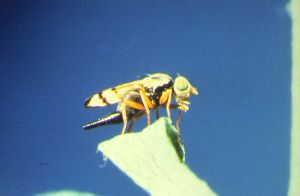(Diptera: Tephritidae)
Biological Control Agent Links. Urophora quadrifasciata



Photos from slide show: Biological Control of Noxious Weeds, by Reeves Petrof, probably all by R. Richard.
Left: Larva (center) and galls of Urophora quadrifasciata (similar to Urophora affinis) in spotted knapweed seed head.
Center: Spotted knapweed seed (left) and gall of Urophora quadrifasciata (similar to Urophora affinis) with larva.
Right: Urophora affinis adult fly.
Genus & Species: Urophora affinis (3)
Order/Family: Diptera: Tephritidae (3)
Origin: Urophora affinis originated in Europe, and was brought to North America in the mid 1900's, first to Canada. (2)
Life Cycle:
Overwintering Stage: Urophora affinis occurs
as
a larva in the winter, and it stays in the seed head gall in the
knapweed
plant. (1)
Egg Stage: The eggs are deposited in the summer in
immature
knapweed seed heads (in the flower buds). They hatch in three to
four days. (1)
Larval Stage: The larva causes the plant to form callous like swelling (gall) in the shape of a hard tear-drop within the seed head. These are called galls. They are made from receptacle tissue of the flower seed head. The larvae feed on the nutritive cells lining of the gall chamber. The larvae spend all fall and winter in the gall. (1)
Pupil Stage: This stage occurs in the gall during late May, and usually lasts about 14 days. (1)
Adult Stage: The emergence of the adults is
timed
by the weather to match the formations of the knapweed flower
buds.
The adult is active during the 2 months of June and July, when the
flower
buds are forming. During this stage they will mate, eat nectar to
survive, and lay eggs in knapweed flower buds. The adults do little or
no damage to knapweed plants. They are usually 4 mm (0.16
in)
long, black, and have faint horizontal bands along the wings. (1)
Damage to Knapweed: Urophora affinis
larvae
form a gall in the seed head, which is a hard shell that they live in
during
all their life except for the adult stage. This stresses the
weed,
and it also slows the seed production of the plant by up to 40%. (2)
Habitat: Urophora affinis is only found on spotted knapweed plants. (2)
Collect, Transport, Release, Redistribute, and how to
Purchase:
You do not have to do any of these because they fly from place to place
themselves and seem to occur whenever spotted knapweed occurs in
Montana.
Because of this, they cannot be commercially purchased. (2)
Links
1) http://www.for.gov.bc.ca/hfp/noxious/index.htm
2) http://www.maes.msu.edu/nwmihort/cff_gallfly.html
3) http://www.invasive.org/browse/detail.cfm?imgnum=0886050
4) http://www.bio-control.com/7cc.asp
5) http://www.nysaes.cornell.edu/ent/biocontrol/weedfeeders/urophora.html
6) http://www.ars-grin.gov/cgi-bin/nigrp/robo/taxon.pl?2071
7) http://www.ceris.purdue.edu/napis/bio/uraf/linkspage.html
8) http://www.ceris.purdue.edu/napis/bio/uraf/index.html
9) http://www.bioone.org/bioone/?request=get-abstract&issn=0046-225X&volume=029&issue=03&page=0403
10) http://ag.montana.edu/warc/biocontrol_agents_of_knapweed.htm
Bibliography
(1) Rees, Norman, et. al., Ed., Biological Control of Weeds in the West, Western Society of Weed Science, in Cooperation with USDA ARS, MT Dept. of Ag, and MT State Univ., Color Printers, Bozeman, MT, Feb., 1996.
(2) Breitenfeldt, Todd, Personal Interview, Biology Teacher, Whitehall Schools, Box 1109 Whitehall, MT 59759. (406)287-3862. 9-1-99
(3) Ronald Lang, USDA-APHIS-PPQ, Forestry Sciences Lab,
Montana
State University, Bozeman, MT 59717-0278. [Online] Available: http://www.intergratedweedcontrol.com/
Last modified: April 23, 1999.
By: John Dawson Published By: Jordan Bowman
Edited by: Ian MacMurdie 2/9/05
Back mtwow.org HOME